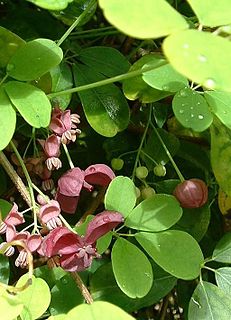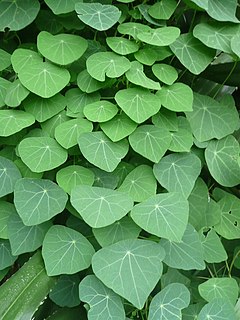
Reynoutria japonica, synonyms Fallopia japonica and Polygonum cuspidatum, is a species of herbaceous perennial plant of the knotweed and buckwheat family Polygonaceae. It is commonly known as Asian knotweed or Japanese knotweed. It is native to East Asia in Japan, China and Korea. In North America and Europe, the species has successfully established itself in numerous habitats, and is classified as a pest and invasive species in several countries.

Lonicera japonica, known as Japanese honeysuckle and golden-and-silver honeysuckle, is a species of honeysuckle native to eastern Asia. It is often grown as an ornamental plant, but has become an invasive species in a number of countries. Japanese honeysuckle is used in traditional Chinese medicine.

Spiraea, sometimes spelled spirea in common names, and commonly known as meadowsweets or steeplebushes, is a genus of about 80 to 100 species of shrubs in the family Rosaceae. They are native to the temperate Northern Hemisphere, with the greatest diversity in eastern Asia.

Camellia japonica, known as common camellia, Japanese camellia, or tsubaki in Japanese, is one of the best known species of the genus Camellia. Sometimes called the rose of winter, it belongs to the family Theaceae. It is the official state flower of the US state of Alabama. There are thousands of cultivars of C. japonica in cultivation, with many colors and forms of flowers. In the U.S. it is sometimes called japonica, a name more often used in the UK for Chaenomeles.

Kerria japonica, also known as the Japanese marigold bush or miracle marigold bush in the northern New England area and as yamabuki (山吹) in Japan, is a deciduous shrub in the rose family Rosaceae, native to China, Japan and Korea. It is named after William Kerr, who introduced the cultivar 'Pleniflora'. It is the sole species in the genus Kerria; its genus name is also used as a common name (kerria).

Akebia quinata, commonly known as chocolate vine, five-leaf chocolate vine, or five-leaf akebia, is a shrub that is native to Japan, China and Korea, and invasive in the eastern United States from Georgia to Michigan to Massachusetts.

Ulmus davidiana var. japonica, the Japanese elm, is one of the larger and more graceful Asiatic elms, endemic to much of continental northeast Asia and Japan, where it grows in swamp forest on young alluvial soils, although much of this habitat has now been lost to intensive rice cultivation.

Ulmus laciniata(Trautv.) Mayr, known variously as the Manchurian, cut-leaf, or lobed elm, is a deciduous tree native to the humid ravine forests of Japan, Korea, northern China, eastern Siberia and Sakhalin, growing alongside Cerciphyllum japonicum, Aesculus turbinata, and Pterocarya rhoifolia, at elevations of 700–2200 m, though sometimes lower in more northern latitudes, notably in Hokkaido.

Ardisia japonica, known as marlberry, is a species of Ardisia native to eastern Asia, in eastern China, Japan and Korea.

Fatsia japonica, also glossy-leaf paper plant, fatsi, paperplant, false castor oil plant, or Japanese aralia, is a species of flowering plant in the family Araliaceae, native to southern Japan, southern Korea, and Taiwan.

Stephania is a genus of flowering plants in the family Menispermaceae, native to eastern and southern Asia and Australia. They are herbaceous perennial vines growing to around four metres tall, with a large, woody caudex. The leaves are arranged spirally on the stem, and are peltate, with the leaf petiole attached near the centre of the leaf. The name Stephania comes from the Greek, "a crown". This refers to the anthers being arranged in a crown like manner.

Spiraea japonica, the Japanese meadowsweet, Japanese spiraea, or Korean spiraea, is a plant in the family Rosaceae. Synonyms for the species name are Spiraea bumalda Burv. and Spiraea japonica var. alpina Maxim.

Actinidia kolomikta, the kolomikta, miyamatatabi, variegated-leaf hardy kiwi, is a species of flowering plant in the family Actinidiaceae, native to temperate mixed forests of the Russian Far East, Korea, Japan and China.

Aucuba japonica, commonly called spotted laurel, Japanese laurel, Japanese aucuba or gold dust plant (U.S.), is a shrub native to rich forest soils of moist valleys, thickets, by streams and near shaded moist rocks in China, Korea, and Japan. This is the species of Aucuba commonly seen in gardens - often in variegated form. The leaves are opposite, broad lanceolate, 5–8 cm (2.0–3.1 in) long and 2–5 cm (0.79–1.97 in) wide. Aucuba japonica are dioecious. The flowers are small, 4–8 mm (0.16–0.31 in) diameter, each with four purplish-brown petals; they are produced in clusters of 10-30 in a loose cyme. The fruit is a red drupe approximately 1 cm (0.39 in) in diameter, which is avoided by birds.

Actinidia polygama is a species of kiwifruit in the Actinidiaceae family. It grows in the mountainous areas of Japan and China at elevations between 500 and 1,900 metres.

Cayratia japonica is a species of herbaceous plant native to Australia and Asia. It is used as a traditional Chinese medicine to relieve swelling and heat, and to enhance diuresis and detoxification.

Marsdenia suaveolens, commonly known as the scented milk vine, is a small vine found in New South Wales, Australia. It is found in a variety of habitats in relatively high rainfall areas, from Bega to Port Macquarie. The original specimen was collected at Sydney on 11 May 1802.

Lygodium japonicum is a species of fern that is known by the common names vine-like fern and Japanese climbing fern. It is native to eastern Asia, including Taiwan, Japan, Korea, southeastern Asia, and India, and eastern Australia. The fern is present in the southeastern United States and Puerto Rico as an introduced species.

Orixa japonica, commonly called East Asian orixa or Japanese orixa, is a deciduous shrub growing to 3 metres (10 ft) with an equal spread. Native to Japan and South Korea, it is found on forested, sunny slopes at elevations from 500 to 1300 m. A recent scientific study found this plant to contain previously unknown alkaloids that may be effective against Plasmodium falciparum, one of the protozoan species that cause human malaria.

Achyranthes japonica, commonly known as Oriental chaff flower or Japanese chaff flower, is a perennial member of the genus Achyranthes in the family Amaranthaceae. It can be discovered on the roadside and its main distribution is in Korea and Japan.





















